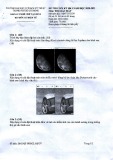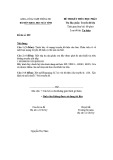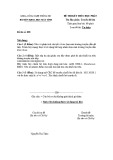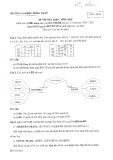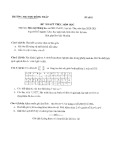

1. Consider a relation Q(A,B,C,D) with the following functional
dependencies:
A → B and B → C
The number of superkeys of Q is:
(a) 2
(b) 3
(c) 4
(d) 5
(e) None of the above
2. Which of the following functional dependencies must be FALSE
?
a) X → Y ⇒ XZ → YZ
b) X → Y; YW → Z ⇒ XW→ Z.
c) X → Y, X → Z ⇒ X → YZ
d) X → Y; Z ⊆ Y ⇒ X → Z
e) None of the above
3. Consider relation S(B, G, U, N, A) with the FD's: BG → U, G →
N, NA→ B

What are all the keys of S ?
a) {B, G} and {N, A}
b) {U, A}
c) {G, A}
d) {B,N}
e) {B, G, U, N}
f) {B, G, A} and {G, N, A}
4. Which one of the following is correct?
(a) All FDs must involve the attributes of the same relation.
(b) All FDs must involve only a single attribute on the left side.
(c) All FDs must involve only a single attribute on the right side.
(d) All FDs must involve only single attributes on both sides.
(e) None of the above
Giáo Trình Cơ Sở Dữ Liệu Trang 95
Biên soạn : Phan Tấn Quốc- Trường Cao Đẳng Kỹ Thuật Cao Thắng
5. Assume the relation R(A, B, C ,D, E) is in at least 3NF. Which of
the following functional
dependencies must be FALSE?

a. A, B → C
b. A, B → D
c. C, D → E
d. None of the above
6. SQL provides a number of special aggregate functions. Which
one of the following is not
included in SQL?
(a) SUM
(b) MAX
(c) MIN
(d) COUNT
(e) MEDIAN
7. Which of the following finds all groups meeting stated
conditions?
(a) Select
(b) Where
(c) Find
(d) Having

8. The ___________ clause is used to restrict the groups returned
by a query.
(a) FROM
(b) WHERE
(c) HAVING
(d) GROUP BY
9. To get all the customers from Hawaii sorted together, which of
the following would be used?
(a) Order By
(b) Group By
(c) Having
(d) Sort
Giáo Trình Cơ Sở Dữ Liệu Trang 96
Biên soạn : Phan Tấn Quốc- Trường Cao Đẳng Kỹ Thuật Cao Thắng

